The fact that you are reading this is proof that I survived two nights camping in Tanzania‘s Serengeti National Park, one of the harshest environments on Earth, without being eaten by a lion. On the first day my guides had warned me not to leave the tent at night, as lions and hyenas regularly came into the camp after dark. But nature called and leaving the tent was unavoidable. Rather than brave the long walk to the squat toilets I crept around the side of the tent at midnight, trembling the entire time I was emptying my bladder.
On the second night the campground filled up and there were tents all around mine, so when the inevitable happened around 2 AM, I braved the walk to the toilets. Earlier in the day my cook, Hamisi, had softened his position about leaving the tent at night, telling me, “Just look for the eyes of the animals in the dark – they are always red.” As I hurried to the toilets the fact that I saw no red eyes was not much of a comfort; I couldn’t see the animals but I could certainly hear them. Hyenas howled in the distance. Closer to camp – quite close – I heard low growls that I assumed to be lions but later found out they were baboons. Even that didn’t make me feel much better, since baboons are vicious – in a pack they can bring down a lion or leopard with their long, sharp teeth.
The Serengeti is a wonder. Upon entering the park my first impression was of a land so severe that it could not possibly support life. I later learned that this was an area known as the southern grasslands – flat, featureless plains for as far as the eye can see – and indeed, there is little animal life in this part of the Serengeti. As we traveled northwest the landscape began to change. Acacia and Sausage trees appeared – the latter so named because it bears a fruit that looks like an overstuffed sausage hanging down on a string, just as in a butcher’s shop. In addition to trees, here and there the plains were relieved by granite outcroppings called kopjes (copies), which are the favorite abode of lions.

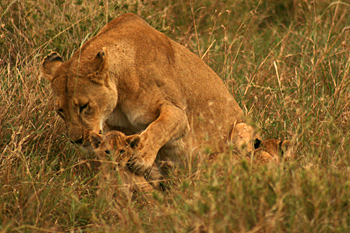

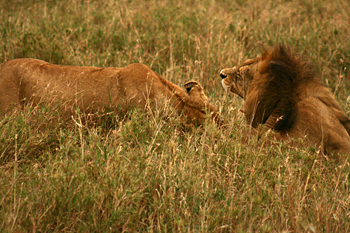
While there is an incredible abundance of wildlife in the park – elephant, giraffe, buffalo, warthog, wildebeest, zebra, dik-dik, Thompson’s gazelle, Grant’s gazelle, hippo, impala, topi – for me the Serengeti experience was all about the big cats. From a distance of about 50 feet I watched a pride of lions consisting of four females, two males, and two cubs lying in the grass.
The cubs scampered off, testing their boundaries, but the mother only let them get so far before she herded them back to the pride. Mom endured the playful cubs climbing all over her, pouncing on her – she even rolled over and put all fours up in the air, allowing the cubs to climb on her belly. The cubs finally settled down when she began to clean them, running her long tongue from head to tail while holding them down with one big paw.
About an hour earlier we had seen a solo female lion walking through the tall grass with her two cubs. Now this same female was approaching the pride we were watching. If she was not a part of this family group the head male would kill the cubs and chase the female off. We held our collective breaths as she came close. At the very last moment she bounded for the alpha lion and they touched noses – my guide said they kissed. They nuzzled necks briefly before the male roared at the female – ‘Enough! Now leave me alone!’
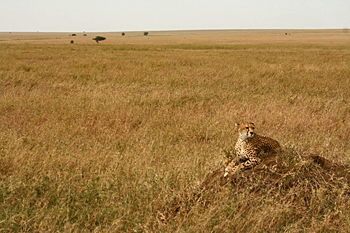
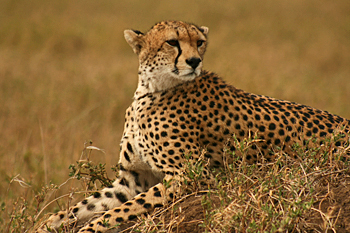
On one occasion my guide, Joseph, got a radio call that a cheetah had been spotted atop a termite mound. We rushed to the site and were able to park 20 feet away and watch for perhaps half an hour as she placidly surveyed her domain from her elevated position, seemingly unconcerned about our presence. The cheetah is such a beautiful animal; the markings are exquisite and she seemed gentle enough to reach out and pet. The reality is that the cheetah, as the fastest animal on earth, is an efficient and dangerous killer.
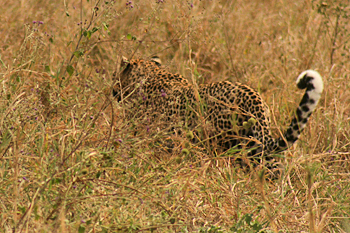

On day two we spotted a leopard up an acacia tree. I’d had glimpsed this same leopard the day before as it crossed the road and disappeared into the tall grasses. Now I had a really good view of him hanging off a thick tree branch, sleepy and satisfied from a recent kill. Unlike the cheetah, who eats on the ground, the leopard always carries his kill up a tree to feed, and the remains of this leopard’s recent meal still hung from the branch upon which he lay.
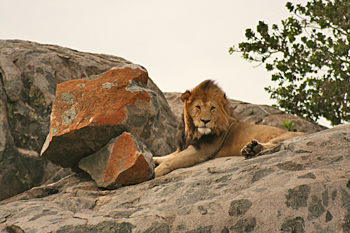
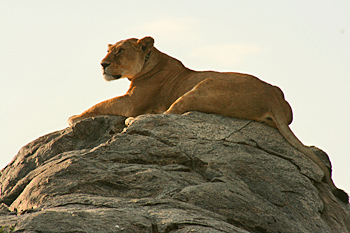
Joseph took me to several more kopjes that he knew to be favorite resting places of lions. At one, a male lay peacefully atop a granite boulder, his head behind the rock and his giant paws hanging off the front. I snapped a photo and quietly said, “OK, now sit up and look at me please.” Immediately, he raised his head and looked directly at me. The moment after I took the photo he went back down to sleep. This ‘communication’ with animals – if it can be called that – happened so often that it could not have been coincidence. I asked the hippo to rise up out of the muddy pond – it did. I asked the ground crane to look up from feeding – it did. At another kopje we spotted a huge female lion draped across a flat granite boulder at the top of the hill. Again I made my request, “Please sit up for me.” She arose and assumed a regal position, clearly showing the radio collar she wore around her neck that allows researchers to monitor her movements and learn more about these amazing animals.
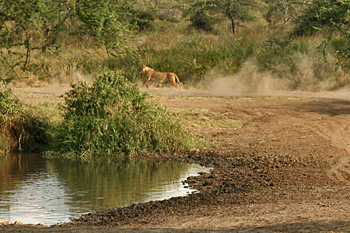
The highlight of my two days at Serengeti had to be the afternoon of the second day when we came upon a herd of zebra nervously crossing the road to get to a waterhole. Another guide alerted us that there was a female lion hiding in the bushes just beyond the waterhole and indeed, when I trained my telephoto lens on the bushes I could clearly see the top of her head and ears. Eventually the zebras wandered too close to the bush. The lion sprang from her hiding place and raced toward the herd. I wasn’t fast enough to get the shot – by the time I’d clicked the shutter all that remained was the lion in the center of a cloud of dust generated by the fleeing zebra.
Joseph has been telling me that I am lucky with animals but I figured that was just something all the guides said to their clients. Yet when we returned to camp each evening no one else had seen a cheetah up close or the number of lions I had seen, much less a lion attacking a herd of zebras.
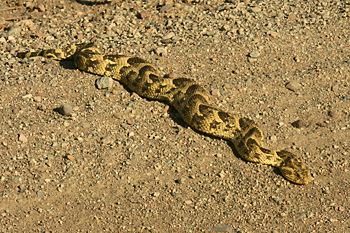
As if to confirm Joseph’s opinion, upon leaving the Serengeti the next morning I was treated to another rare sight – a three-foot long puff adder snake sunning himself on the road. The snake patiently waited for our jeep to back up so I could take a photo, then slithered off into the desert brush where, with its ideal camouflage markings, he was instantly invisible. I shuddered at the thought of one misplaced step – a puff adder bite means you have only five minutes to live.
The Serengeti is a vivid illustration of the law of survival in action. Today we are on our way to Ngorogoro Crater, which, although located adjacent to the Serengeti, has evolved as a completely different ecosystem. It will be interesting to contrast and compare the survival mechanisms the animals at Ngorogoro have developed with those of the Serengeti.

Hi, Barbara. Just saw your recent post on your Africa trip on by Facebook link. You are so awesome. Kathy and I just planned a retirement trip for us and a couple of friends to Zimbabwe and Botswana in February. OMG, it was so expensive. We would like to go back to Africa again because there is so much to see but it is such an expensive place. I know you usually travel on a limited budget so I was wondering how you accomplished such an amazing task. We want to go back once Kathy retires so we can spend several months there. We’ve also decided that, when we are both finally retired, our travels will involve several months at a time in different place where we can get more in depth into the local scene.
By the way, I still love to follow your amazing adventures.
Regards,
Chuck Coker
Hi Chuck: Well, I went to Africa back in 2007 when I had just walked away from my real estate career and before I lost all my properties, so I had enough money back then to do a proper safari. With what I know now, I’d never do that again. I’d travel independently to the country and arrange a safari while there. I’d cut my cost by at least half that way and have complete confidence in doing it that way. But it’s not for everyone; many people like to have the security of an arranged trip. The other think you can try is going into the Lonely Planet Thorn Tree Forum for the country you want to visit and leaving a message about hooking up with others looking to do a similar trip and sharing the cost four ways. Love it that you plan to spend an extended time there; it’s the only way to really get a feel for the local culture.
nice theme
“They” say that travel changes you forever. You will probably never be the same again. In awe and wonder over the magnificent photography. I’m off to the Food Lion right now! That won’t change me much! But leaving for Europe and St. Petersburg, Russia on Thursday. And so it continues…in gratitude. Thanks. Ellie
One time at the National Zoo, I was treated to the sound of a male lion roaring — the ground shook with the majestic roar — I can only guess what it must sound like in the Serengeti. I am so happy that you are having such an incredible trip and I once again thank you for sharing it with us. Like Ellie, however do you get internet service in the Serengeti? Sometimes we don’t get it here in California!! Karen